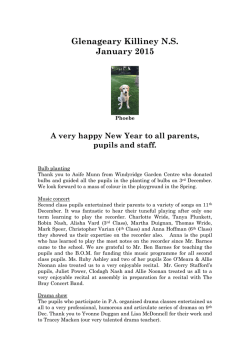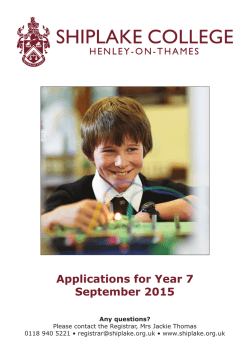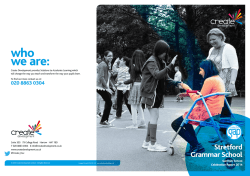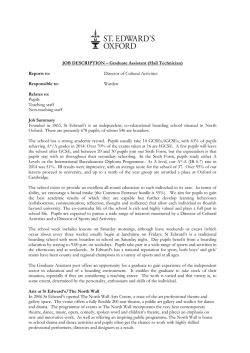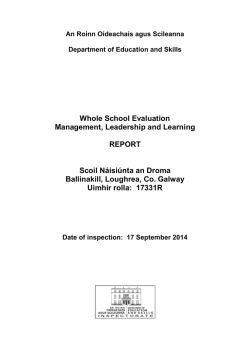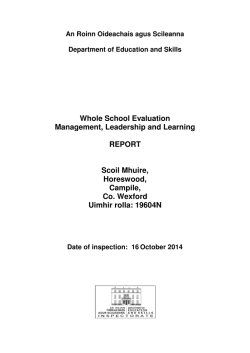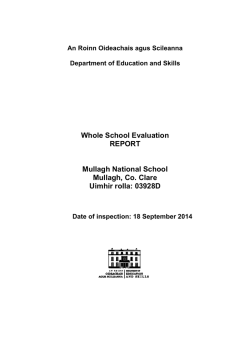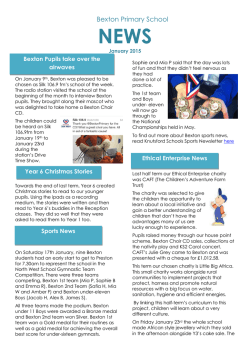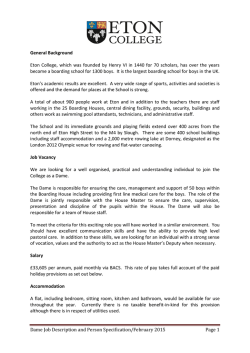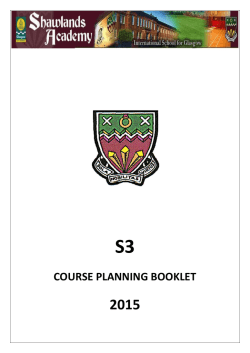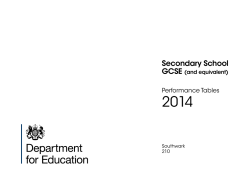
Whole School Evaluation Management, Leadership and Learning
An Roinn Oideachais agus Scileanna Department of Education and Skills Whole School Evaluation Management, Leadership and Learning REPORT Scoil Náisiúnta an Chillín Ballyshrule, Portumna, Co. Galway Uimhir rolla: 13665D Date of inspection: 1 October 2014 Whole-School Evaluation – Management, Leadership and Learning Report Introduction A Whole-School Evaluation – Management, Leadership and Learning (WSE - MLL) was undertaken in Scoil Náisiúnta an Chillín in the autumn of 2014. This report is based on a selection of lessons observed in a range of learning settings in the school, interaction with pupils and review of their work, meetings with the principal and with board and parent representatives, completed parent and pupil questionnaires, and a selection of school documents. The board of management of the school was given an opportunity to comment in writing on the findings and recommendations of the report, and the response of the board will be found in the appendix of this report. Scoil Náisiúnta an Chillín is a rural primary school under Catholic patronage, located approximately eight kilometres from the town of Portumna in Co. Galway. There are fortythree pupils currently enrolled and this figure represents an almost 50% increase in enrolment over the last five years. Pupils’ overall attendance levels are very good. The school has strengths in the following areas: • • • • • • The teachers display a deep commitment to the holistic development of their pupils. They bring a range of skills to their teaching, in Art, Technology and Music, which enriches the learning experiences for pupils. A cohesive and effective management structure, involving a supportive board of management and an effective in school management team, ensures that the school is ready and able to meet current and future challenges. The school, which is the key focal point of this rural community, is open and welcoming. There is a very good atmosphere and strong sense of collegiality among staff. School policies and practices embody a solid commitment to inclusive education. Extensive upgrading of the building and grounds has been carried out over the past eight years and the school is maintained and resourced very well. The quality of support for pupils’ well-being is excellent. The following main recommendations are made: • • Moltar tús áite don chur chuige cumarsáideach a fhorbairt sa Ghaeilge, trí dheiseanna níos minice a thabhairt do na daltaí an fhíorchumarsáid a chleachtadh, ó bhéal agus ar phár. It is recommended that the school prioritise the development of the communicative approach in Irish, by giving the pupils more frequent opportunities to practice communication, both orally and in writing. In the context of its assessment policy, the school should review how targets for improvement in student achievement are set. This review should also address how progress towards meeting the targets set in improvement plans is to be monitored. Particular attention should be afforded to the individual progress of special needs pupils. 1. The learning achievements of pupils • The overall learning achievements of pupils, including those with special educational needs, are good, with the majority of pupils achieving at or above their ability levels. Through initiatives such as Reading Buddies and Shared Reading, as well as the provision of well-stocked libraries in various reading genres, the teachers have successfully promoted fluency, confidence and an interest in reading among the pupils. Most pupils display good levels of confidence orally. • Annual tracking of performance in standardized tests indicates that the pupils are making consistent progress in numeracy. While the school is putting particular emphasis on developing problem solving skills, there is also a need, for some pupils, to continue to develop basic computational competencies through mental Maths activities. • Sa Ghaeilge, tá scileanna éisteachta agus tuisceana na ndaltaí á bhforbairt go maith, go háirithe sna bun ranganna. Is léir go bhfuil an bhéim láidir a leagtar ar rainn agus amhráin sna ranganna sin ag cothú dea-thoil na ndaltaí seo i leith na Gaeilge. Sna meánranganna agus sna hardranganna léiríonn na daltaí gnóthachtáil sásúil ina scileanna léitheoireachta. D’fhonn tuilleadh fianaise a bhailiú ar dhul chun cinn foriomlán na Gaeilge sa scoil, b’fhiú triail chaighdeánach sa Ghaeilge a riaradh. In Irish, the pupils’ listening and comprehension skills are developing well, particularly in the junior classes. It is evident that the strong emphasis placed on rhymes and songs is fostering a positive attitude towards Irish among these pupils. In the middle and senior classes, the pupils demonstrate satisfactory attainment in reading skills. In order that further evidence might be gathered on overall progress in Irish in the school, it would be worthwhile administering a standardized test in Irish. 2. Quality of teaching • The overall quality of teaching in the school is good. The teachers are highly skilled and make commendable efforts to utilise engaging teaching methods. Worthwhile emphasis is placed on environment-based learning, the use of information and communications technology (ICT) and on promoting language development across the curriculum. • Mathematics concepts are carefully explored and explained. In order to achieve further gains in Mathematic attainment, plans have been developed to adopt a whole school problem solving strategy and a Maths for Fun initiative. In regard to problem solving it is advised that pupils be given opportunity to explore a smaller number of problems in greater depth and to engage in collaborative problem solving. • There is a significant oral component to lessons in English and lessons in other subject areas. Pupils are given suitable opportunities to develop their ability and confidence in oral expression. There is a particular focus on developing pupils’ comprehension skills. Some exploration of the different writing genres has been carried out and this work merits further development. Further gains in overall literacy standards should be possible through a sustained focus on vocabulary expansion and spelling. • Sa Ghaeilge déantar iarrachtaí inmholta na daltaí a spreagadh trí chluichí teanga mealltacha. Tugadh faoi deara go raibh obair fhóinteach ar siúl le hamhráin agus dánta agus gur leagadh béim chabhrach ar mhúineadh na héisteachta. Chun cur leis an obair seo is den riachtanas é tuilleadh oibre a dhéanamh i bhforbairt scileanna cumarsáide na ndaltaí. I dtaca leis seo moltar cumarsáid Ghaeilge neamhfhoirmiúil a chothú i rith an lae scoile, agus deiseanna níos minice a chur ar fáil do na daltaí píosaí gearra scríbhneoireachta, i seánraí éagsúla, a chur ar phár. In Irish, praiseworthy efforts are made to encourage the pupils’ oral skills through the use of engaging language games. It was noted that good use was made of songs and poems and that the teaching of listening skills was suitably emphasized. To maximize the benefits of this approach, it will be necessary to develop pupils’ communicative skills to a greater extent. In this regard it is recommended that informal communication in Irish be developed during the school day and that pupils be given more frequent opportunities to write short pieces in various genres. • Support for pupils with special educational needs is well organised, delivered in an empathic manner and features very good co-operation with external agencies and professionals. A range of diagnostic tests is used to enable teachers focus on the areas of greatest need for pupils. In compiling educational plans for pupils some specific attainment targets are included. This aspect of the work merits further development so that pupils can be seen to have achieved minimal ratio gains, where feasible. At whole school level there is need for a unified approach to the maintenance and updating of the record of support for pupils and progress made. The support teachers are also involved in the delivery of an early intervention literacy programme in the junior classroom. This initiative is developing well. 3. Support for pupils’ well-being • The pupils are managed and cared for very well. During the evaluation their interactions with their teachers and with each other were positive and respectful. Their work is celebrated throughout the school and on the school’s website. Participation in the achievement of the Active School Flag has been a particularly positive experience for pupils. Efforts made to ensure meaningful inclusion of pupils with special educational needs are highly commended. • From the analysis of questionnaires administered to pupils it can be determined that, overall, they have very positive opinions of school life. Parents expressed similarly positive attitudes in their responses to a questionnaire. All parents agreed that there was a good atmosphere in the school, that parents were welcome and that the school was well run. • Confirmation was provided that the board of management has formally adopted the Child Protection Procedures for Primary and Post-Primary Schools without modification and that the school is compliant with the requirements of the Child Protection Procedures for Primary and Post-Primary Schools. 4. Leadership and Management • The carefully minuted activities of the board of management are illustrative of the professional manner in which the board supports the work of the school. Extensive improvements have been carried out to the building and grounds over a number of years and maintenance and resourcing are of a high order. Finances are prudently managed. Accounts should be certified at the earliest opportunity. • The principal has successfully cultivated a collegial atmosphere in which all members of staff are affirmed and encouraged. She successfully promotes regular reflection on teachers’ practice and an openness to new learning. She is well supported by the deputy principal, support teachers and ancillary staff. A yearly plan of work to guide the deputy principal in her role has been agreed and this practice is commended. 5. School Self-evaluation • The school has engaged with the self-evaluation process in a positive and constructive manner. Over the past two years data on literacy and numeracy has been gathered and analysed and detailed improvement plans put in place to improve aspects of pupils’ reading and writing and numeracy skills. In order that plans will be more focused and give rise to a greater sense of motivation, it is recommended that specific targets for improvement be identified and progress regularly evaluated. A summary of the school self-evaluation report has been prepared for dissemination to parents. Conclusion The school’s capacity to engage in school improvement is very good. Published January 2015 Appendix SCHOOL RESPONSE TO THE REPORT Submitted by the Board of Management Area 1 Observations on the content of the inspection report The Board is grateful that the commitment and collegiality of the staff, the open welcoming atmosphere of the school and the positive and respectful behaviour of the pupils have all been recognised and praised, as they are the key strengths that the school prides itself on. Area 2 Follow-up actions planned or undertaken since the completion of the inspection activity to implement the findings and recommendations of the inspection. The Board welcomes the recommendations of the report. All recommendations will form the basis of future planning and will be reflected in the school’s action plans with immediate effect.
© Copyright 2026
